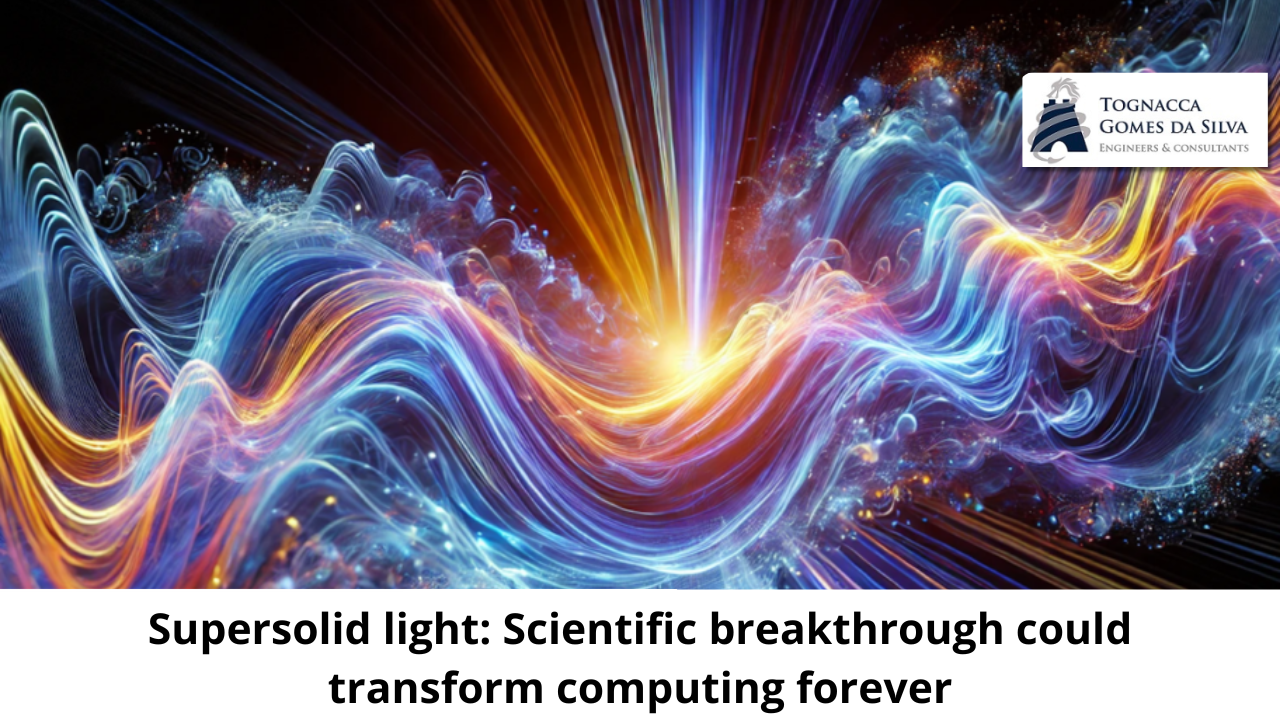For the first time in history, scientists have managed to transform light into a supersolid, a quantum state of matter that could revolutionize the superconductor industry and even quantum computing in the near future. The study was published in the renowned scientific journal Nature in early March.
The experiment was carried out with polaritons, hybrid particles of light and matter, in a photonic crystal specially designed by an international team of researchers led by Dimitrios Trypogeorgos and Antonio Gianfrate, from CNR Nanotec (Institute of Nanotechnology) in Italy, in collaboration with scientists from the University of Innsbruck (Austria), University of Pavia (Italy), University of Trento (Italy), Berkeley National Laboratory (USA) and Princeton University (USA).
What is a supersolid and why is it so awesome?
Supersolids are one of the most mysterious states of matter. They combine the properties of a solid—that is, an ordered and rigid structure—with the fluidity of a superfluid, meaning they can flow without resistance. This makes them highly promising for a variety of technological applications.
Until now, this phenomenon had only been observed in ultracold atomic gases. But now, researchers have managed to create this exotic state using photons coupled to quasiparticles—a groundbreaking technique that could facilitate the exploration of supersolids in controlled environments.

🔍 What are polaritons and the role of photonic crystal?
To do this, the researchers used polaritons, which are hybrid particles. They are created when a photon (a particle of light) couples with an exciton (a type of “hole” created when an electron is excited in a material). This marriage between light and matter generates a new type of particle, which can be manipulated in unique ways.
But where do these particles get “trapped”? The answer lies in the photonic crystal, which acts as a type of cage for light. It is a material designed to confine and guide photons in a controlled manner, allowing them to interact strongly with matter and create new properties.
Inside this crystal, the polaritons were organized in a way that broke spatial symmetry, forming an ordered pattern, but still flowing like a quantum liquid. In other words, light was transformed into a supersolid!
This may seem like a distant concept from today’s technology, but it paves the way for new forms of computing and electronics, using light in ways never seen before!
How did scientists create a supersolid with light?
As we saw above, the experiment was performed in a polariton condensate — a system where light interacts strongly with matter. Using a photonic crystal, the scientists were able to manipulate the light so that the photons combined with electronic excitations of the structure, forming an ordered and cohesive state, but one that can still flow freely.
This approach allowed the team to observe behavior typical of supersolids, such as the spontaneous breaking of translational symmetry, a phenomenon that confirms that light has indeed assumed this new state of matter. It works like this:
Step 1: Choosing the experimental platform
The researchers used a specially designed photonic crystal, which acts as a confinement medium for light and matter.
Step 2: Creating polaritons
A condensate of polaritons was used, which are hybrid particles formed by the interaction between photons (light) and excitons (quasiparticles of matter) within the crystal.
Step 3: induction of the condensation state
The scientists cooled the system to cryogenic temperatures, probably in the range of a few tens of Kelvin (above absolute zero, but still extremely cold). With this reduction in temperature, the polaritons began to behave collectively, forming a Bose-Einstein Condensate (BEC), a prerequisite for the creation of the supersolid. To stimulate this process, a pulsed laser was used, exciting the polaritons and allowing them to enter this special quantum state.
Step 4: Density modulation
The photonic crystal imposed a periodicity on the polaritons, creating a modulation in the density of the condensate. This is crucial for the formation of the supersolid state.
Step 5: Observation of supersolidity
The team measured properties of the system and observed spontaneous translational symmetry breaking, a signature that the light was exhibiting supersolid behavior.
Step 6: Coherence and stability analyses
Interferometric measurements were made to verify the coherence of the quantum state, confirming that the polaritons maintained supersolid behavior without phase loss.
Step 7: Study the impact on future applications
The researchers analyzed the potential use of the supersolid of light in superconductors, quantum computing and photonic devices.
The role of extreme temperatures
Supersolids can only exist under extreme conditions, at temperatures close to absolute zero (-273.15°C).
In this range, the thermal agitation of the particles practically disappears, allowing quantum effects to take control of the system. This creates an ideal environment for unusual properties, such as the fusion between solidity and fluidity, to emerge.
When there is not enough heat to cause random movement of the particles, they spontaneously organize themselves into an ordered structure, without thermal interference. This behavior leads to the formation of an extremely stable material with no viscosity, something that does not occur in conventional fluids, which always present resistance to movement.

💡 A real example: helium-4
A well-known form of this phenomenon occurs with helium-4. When cooled to extreme temperatures, it becomes a superfluid, capable of flowing without resistance and even defying gravity, climbing the walls of its container. This happens because it enters a quantum state where the normal laws of fluids no longer apply.
Now, with the creation of the supersolid of light, scientists have demonstrated that these quantum properties are not limited to just atoms.
The impact on quantum computing and future hardware
What makes this discovery even more exciting is its potential impact on the world of computing and electronic devices. After all, the discovery could lead to impressive advances in quantum computing, high-efficiency superconductors, and even new types of frictionless lubricants for cutting-edge technology.
Supersolids could help pave the way for:
- More efficient superconductors: The absence of resistance could allow lossless transmission of electricity, improving high-performance computing networks.
- Quantum computing: The supersolid state can help in the development of more stable qubits, increasing the efficiency and reliability of quantum computers.
- Ultrafast memories: supersolid-based devices could store and process information at unprecedented speeds
- New materials for chips and circuits: the possibility of creating quantum surfaces that combine fluidity and structure paves the way for innovative architectures.
The research shows that light can be controlled in unimaginable ways, opening the door to a future where quantum computing reaches levels of efficiency previously thought impossible.
Supersolids of Light vs Current Technologies
| Parâmetro | Supersólidos de Luz | Tecnologias Atuais (Silício) |
|---|---|---|
| Temperatura de operação | Criogênica próximo ao zero absoluto (~-273°C) | Temperatura ambiente (~25°C) |
| Velocidade de processamento (teórica) | Potencialmente 1000x mais rápidoque semicondutores convencionais | Geralmente até alguns GHz (1-5 GHz em CPUs comuns) |
| Consumo de energia | Extremamente baixo(quase sem dissipação de calor) | Médio a alto (dissipação de calor requer resfriamento) |
| Escala de fabricação | Ainda em estágio experimental, sem produção em larga escala | Produzido em escala massiva(bilhões de chips por ano) |
| Tempo de desenvolvimento até aplicação comercial | Estimado em pelo menos 10-20 anos | Já consolidado, evolução incremental a cada ano |
( fontes: Adrenaline )



